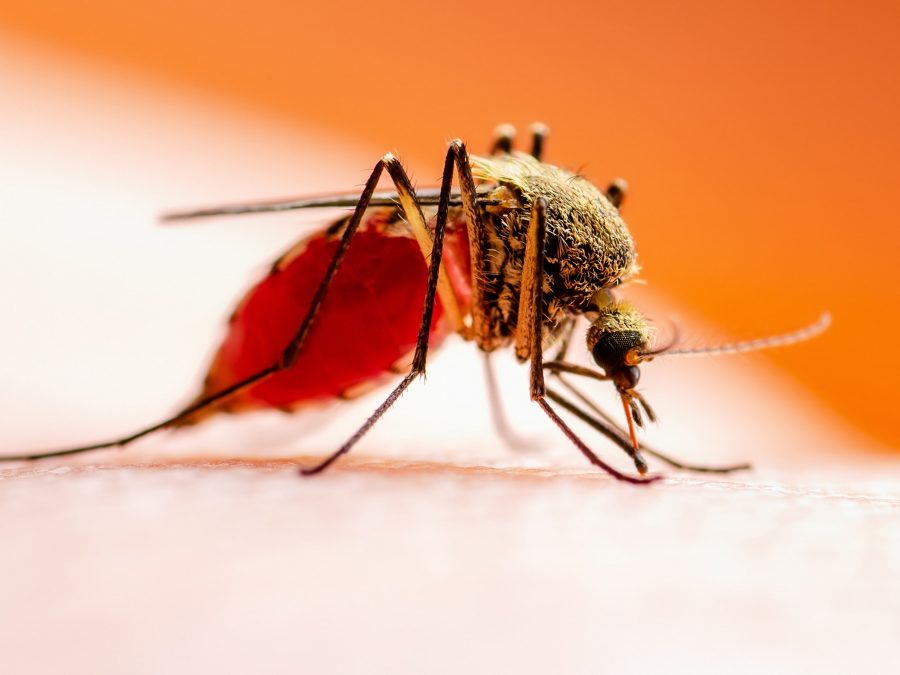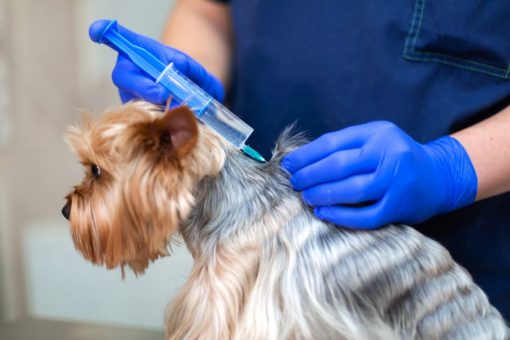Canine leishmaniasis is an infectious disease that is transmitted by sandfly vectors, called phlebotomine.
Similar to tiny mosquitoes, these insects develop the biphasic parasite that causes the disease.
This condition is widespread in more than 70 countries in the world and it is most common in summer and autumn. In the last 10 years there has been a significant increase in infections.
It is important to be aware of this disease, especially in summer and autumn, since phlebotomine is infectious when the temperature is above 19 degrees.
Therefore, the most affected areas of Europe are the southern regions. However, it has been spreading to the northernmost territories as well.

Leishmaniasis can’t be transmitted directly from dog to dog, since the vectors, i.e. the phlebotomine, are the sole responsible for its spread.
Depending on the severity of the disease, three types of leishmaniasis can be identified: leishmania tropica, leishmania braziliensis – responsible for skin lesions – and leishmania donovani. The latter form in particular can be found in Italy and can lead to death.
Symptoms of Canine Leishmaniasis
Since canine leishmaniasis is a serious condition, it is important to intervene promptly by recognizing the first symptoms that dogs may experience.
Consequently, you should start worrying if your dog shows these signs: apathy, skin lesions, hair loss, foot and ear irritation, blood loss, fever, vomiting and increased spleen volume.
In order to treat this disease right when it first appears, you should carry out periodic checks, especially at the end of summer.
Even though leishmaniasis cannot be cured, its effects can be reduced. You could make your dog run different types of tests, like the SNAP Leishmania, the ELISA and the PCR test.
During these tests, blood is taken from the animals to check if they have contracted the disease.
In case pets are found to be infected, they will have to undergo an antibiotic-based treatment to stop the infection from spreading.
However, they will have to continue their therapy for the rest of their life.
Treating Canine Cutaneous Leishmaniasis
Leishmaniasis can occur through signs on the skin of dogs in 56%-90% of cases. These events can be typical or atypical. In the first case they are exfoliative, ulcerative or nodular dermatitis.
Exfoliative dermatitis is the most common and can affect animals of all breeds and ages.

Ulcerative dermatitis, on the other hand, occurs mainly in the limbs, while nodular dermatitis is a less common form that is distinguished by the presence of nodules of different sizes.
The treatment of leishmaniasis can only attenuate the symptoms and it initially involves injections of antibiotics to slow down the development of the agent responsible for the disease.
If you want to make sure that your dog can undergo specific treatments, you should first consult your vet, since certain therapies could have significant side effects.
To be safer, you need to vaccinate your dog with an injection that reduces the risk of contracting the disease, especially if you live in at-risk areas such as southern Europe.
Unfortunately, there is still no vaccine that can completely prevent infection.
Ocular Manifestation of Leishmaniasis
Leishmaniasis is a parasitic disease that spreads through sandflies called phlebotomine. These insects are common in the southern European areas. Since the incubation of the phlebotomus, the responsible bacterium, takes place at temperatures above 19 degrees, most infections occur between May and June. According to the most recent studies, the age and sex of dogs do not seem to be related to the chances of contracting the disease.
The symptoms of leishmaniasis are varied. The disease can in fact attack the visceral areas of animals, their skin or their eyes. Ocular signs, such as keratoconjunctivitis sicca, uveitis and panophthalmitis, appear less rarely than others.
Keratoconjunctivitis sicca consists in poor production of the watery component of tears which can cause inflammation of the conjunctiva and the cornea. Also known as dry eye syndrome, it accounts for more than a third of all eye diseases affecting dogs.
It is possible to suspect that dogs have this disease if they have opaque eyes, persistently close their eyelids as they experience pain, or if they have dry, reddened nostrils.
Leishmaniasis and Long Nails
Leishmaniasis presents different symptoms depending on the immune response of the dogs. Moreover, since it has very long incubation periods (from 2 months to 4 years), dogs can show their first symptoms after a fairly long period of time. The first visible signs are those on the skin, such as ulcers and dermatitis, found mainly on the legs, nose and ears.
One of the symptoms is onychogryphosis, i.e. excessive nail growth. Onychogryphosis is a real disease, which is often a consequence of other conditions. The affected nails thicken, take on a hook shape and stretch downwards.
Onychogryphosis causes a lot of pain to dogs. That’s why it is important to take a blood test right after the first symptoms appear. Depending on the results of the test, your vet will decide whether a further investigation is required in order to understand the root causes. If the symptoms are caused by leishmaniasis, the treatment will depend on your dog’s age and health conditions.
Anemia in Dogs Affected by Leishmaniasis
In addition to checking the symptoms already mentioned and paying general attention to our beloved pet in order to understand if he caught leishmaniasis, it is advisable to run blood tests.
It is not unusual to run tests after some time has passed from the moment of contagion, since the insects that injects the parasite leishmania infantum are very similar to mosquitoes – and their feeding habits are as well.
The most affected body areas for our furry friends are the ears, nose and abdomen. The parasites only need a few seconds to feed, but will leave visible signs for several weeks as single or multiple lesions at the epidermal level.

Dogs affected by canine leishmaniasis develop also normochromic normocytic anemias. To make it simple, this kind of anaemia belongs to the class of infections or chronic inflammations. Since it is a hypo-regenerative form, the spleen tends to destroy more red blood cells, the number of platelets tends to decrease and proteins in the blood will increase.
Is leishmaniasis curable?
As far as leishmaniasis is concerned, it is not possible to speak of an actually full recovery. Cases of complete healing are rare and give hope to the most optimistic owners.
However, you can take advantage of the therapies that have been studied in recent years and are constantly being updated to improve and lengthen the life of your beloved pet.
Since it is not a fulminant disease, being able to diagnose it as soon as possible can make a difference – that is also valid for human diseases. However, it is not always easy to move in time, as the incubation period for leishmaniasis ranges from several months to 7 years.
You could then suddenly discover that your four-legged friend has been suffering from leishmaniasis for some time without you noticing or taking precautions. Moreover, the symptoms of the disease are not clinical, thus making them hard to identify.
On top of that, the conditions of your beloved pet may improve for a certain period of time but worsen immediately afterwards or after years. As a consequence, even if your dog seems to have recovered from canine leishmaniasis, it is advisable to keep a very close eye on his physical state and be ready to face a relapse.
Cost of Canine Leishmaniasis Treatments
Let us focus on some more technical details on how to treat canine leishmaniasis. There are two main ways of treating this condition, i.e. pharmacological treatments or homeopathic treatments. More specifically, vets usually recommend these drugs:
- Meglumine antimoniate (Glucantime): its administration can be prolonged for several weeks depending on your dog’s immune system response;
- Miltefosin (Milteforan);
- Allopurinol.
The cost depends of course on the type of therapy.
For example, the drugs listed to treat canine leishmaniasis have very different prices: Allopurinol costs from 2,50 to 3,00 euros, Glucantime is around 15 euros, while Milteforan may even exceed 200 euros. These are just indicative numbers, since – as we know – each retailer is free to choose the final purchase price.
In any case, it is essential to remember that it will still be the duty of the vet to recommend doses and/or other therapies according to the stage of the disease. Only a professional, in fact, is able to refer to the actual health condition of a dog and advise his owners of the best solution.
Homeopathic Treatment of Canine Leishmaniasis
An alternative way of treating your dog without excessive use of medication may be to combine a healthy diet with homeopathic treatments. To make sure your dog follows a correct diet, you must remember some valid principles that you can also have confirmed by your vet. From a nutritional point of view, it may help you to know that:
- A high content of antioxidants acts as an immunostimulant and is therefore great for dogs of a weak disposition;
- An adequate level of protein also facilitates the reproduction of muscle mass;
- It is better to reduce the content of purine bases, as they only lead to kidney problems and stone formation.
With regard to homeopathic treatments of leishmaniasis, it is always recommend to seek advice from an expert. However, it is likely that your vet will advise you to get started with supplements that can easily be found on the market.
Cost of Vaccines for Canine Leishmaniasis
You can opt for a vaccine to prevent leishmaniasis, but this does not ensure absolute immunity throughout the whole life of your dog. The injection, in fact, reduces by about 90% the possibility that animals have of being infected by the disease and it also strengthens their immune system, which is very comforting for dog lovers.
To reduce the risk of infection, however, it is advisable to avoid areas marked as dangerous, such as parks or streets where cases have already occurred and dogs with leishmaniasis are known to live. It must be said, however, that the infection does not occur as easily as you might think. Moreover, dogs can live with leishmaniasis for a long time – provided that it is discovered and treated in time.
When it comes to the price, the leishmaniasis vaccine – both for puppies and adult dogs – costs about 210 euros, to which will be added the costs of the various boosters of about 70 euros each. You will have to perform these vaccines respecting the frequency advised by your vet and depending on the needs of your faithful friend. The price may look very high, but you should consider that you will be paying for 3 injections which are to be performed over the course of a year.The price can obviously vary according to the country. For example, it may decrease a lot in the most affected areas because veterinarians may try to help owners facing financial difficulties by making the vaccine accessible to those who, normally, might not afford it.
